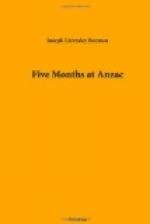All the graves were looked after by the departed one’s chums. Each was adorned with the Corps’ emblems: thus the Artillery used shell caps, the Army Medical Corps a Red Cross in stone, etc.
THE ENGINEERS
The Engineers did wonderfully good work, and to a layman their ingenuity was most marked. Piers were made out of all sorts of things; for instance, a boat would be sunk and used as a buttress, then planks put over it for a wharf. They built a very fine pier which was afterwards named Watson’s. Again, the “monkey” of a pile driver they erected was formed out of an unexploded shell from the Goeben. This warship, a German cruiser taken over by the Turks, was in the Sea of Marmora, and occasionally the Commander in a fit of German humour would fire a few shells over Gallipoli neck into the bay—a distance of about eight or nine miles. As soon as the Goeben began firing, one of our aeroplanes would go up, and shortly afterwards the Queen Elizabeth could be seen taking up a position on our side of the Peninsula, and loosing off. Whether she hit the Goeben or not we never heard. It was Mafeesh.
The Engineers also made miles upon miles of roads and, furthermore, created the nucleus of a water storage. A number of large tanks from Egypt were placed high up on “Pluggey’s,” whence the water was reticulated into the far distant gullies.




